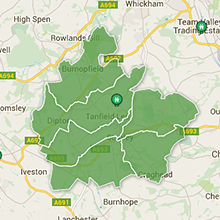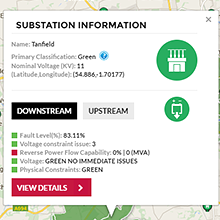GENERATION HEAT MAP
Accessing our generation heat map and downloadable data
Our generation availability heat map is designed to give you a high-level indication (red/amber/green) of our network’s capability to facilitate new connections.
In addition to a web view, you can also access free, downloadable network data sets. This data is updated monthly and provides important guidance and assumptions to be aware of when considering a new connection. All data was correct at the point in time it was produced. A full design study will be required before any connection offer can be made.
To access our generation heat map and downloadable data, accept the ‘Terms and Conditions’ below and click ‘Continue’. If you have any questions, you can email our team.
Network constraints
We are seeing a significant increase in volumes of new connections applications at both the transmission and distribution level and are aware that our customers may be facing long delays and increased costs as a result of constraints on the transmission network that will require major reinforcement works and could impact on their ability to connect to our distribution network.
We are committed to working with NGET, NGESO and those customers directly impacted to explore all possible solutions and to being open and transparent about what we know.
We are updating our network availability heat maps with information on known constraints at the affected Grid Supply Points (GSPs). We will review this information on a monthly basis and update it when we receive outcomes from National Grid, so that our customers can make more informed choices about how and where to connect.
The NGET website features further information on transmission constraints and reinforcement works required in our region nationalgridet.com/pre-application.
Legal disclaimer: We have developed the generation availability map to assist you with connections applications in constrained areas. They give a general illustration of generation availability constraints only and cannot be relied upon to assess the terms of connection for specific premises. Nothing in this disclaimer limits or excludes our liability for (a) death or personal injury caused by our negligence; (b) fraud or fraudulent misrepresentation; or (c) any other liability that cannot be limited or excluded by applicable law. Subject to the above, we shall not be liable to you in tort (including negligence) or otherwise, arising under or in connection with your use of the generation availability map for: (a) loss of profits; (b) loss of sales or business; (c) loss of agreements or contracts; (d) loss of anticipated savings; (e) loss of or damage to goodwill; or (g) any indirect or consequential loss.
Use the icons to display areas of high, medium and low availability/demand.
Use the icons to display the specific supply types.
Roll over a supply type to see the post code it covers.

Click on a supply type to find out related information.

Choose to view downstream (availability) or upstream (demand) information.













CONNECTIONS ENQUIRIES
0800 011 3433
getconnected@northernpowergrid.com
MON - FRI:
8am - 8pm
SAT:
9am - 5pm
Have you checked out our Help & Advice directory, it may just have the answers that you're looking for.

